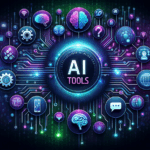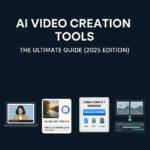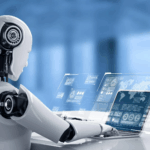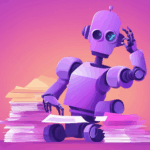Space exploration has always pushed the boundaries of human imagination and technology. From the first moon landing to today’s missions to Mars and beyond, every breakthrough has relied on innovation. Now, a new era is unfolding — one where AI in space exploration is becoming a game-changer.
Artificial intelligence is no longer confined to science fiction. It is actively helping space agencies like NASA, ESA, and private companies such as SpaceX analyze massive datasets, control autonomous rovers, predict spacecraft malfunctions, and even identify new planets. AI is not replacing human ingenuity, but rather augmenting it with speed, precision, and problem-solving capabilities that were previously impossible.
At AI of the Decade, we explore how AI is shaping industries — and space is one of the most exciting frontiers. In this article, we’ll look at how AI is used in missions, astronomy, Mars exploration, satellites, and future research, along with its benefits and limitations.
The Role of AI in Space Exploration
Artificial intelligence has become a cornerstone of modern space research and mission planning. Space exploration generates vast amounts of data, requires autonomous decision-making, and often happens in environments where human intervention is limited or delayed due to distance. Here’s how AI plays a critical role:
Mission Decision-Making and Autonomy
- Space missions often operate millions of kilometres away from Earth, where communication delays make real-time human guidance impossible.
- AI systems onboard spacecraft and rovers can make split-second decisions — such as navigating rough terrain on Mars or adjusting a satellite’s course to avoid collision.
- This autonomy increases efficiency and reduces risks in deep-space missions.
Data Processing and Analysis
- Telescopes like Hubble and James Webb produce terabytes of raw astronomical data.
- AI helps filter, process, and interpret this data to detect exoplanets, identify black holes, and analyse cosmic radiation patterns.
- Without AI, it would take years of manual labour for scientists to process what AI can handle in days.
Robotics and Rovers
- NASA’s Mars rovers, such as Curiosity and Perseverance, rely heavily on AI for mobility.
- AI allows rovers to map terrain, avoid hazards, and conduct experiments without waiting for instructions from Earth.
- This capability enables longer and more complex missions on planets where human presence is not yet possible.
Communication and Navigation
- AI optimises communication between Earth and spacecraft, helping manage bandwidth and reducing errors.
- Autonomous navigation systems powered by AI allow satellites and probes to adjust trajectories mid-flight without waiting for human commands.
- This is vital in long-distance missions, such as those to Mars or beyond our solar system.
Predictive Maintenance and Safety
- AI continuously monitors spacecraft health, identifying potential equipment failures before they happen.
- This predictive capability helps extend mission life, reduce costs, and ensure safety in critical operations.
AI in NASA Missions
NASA has been at the forefront of using AI in space exploration, integrating intelligent systems into almost every stage of mission design, execution, and data analysis. With missions that extend millions of kilometres from Earth, autonomy and machine intelligence are no longer luxuries — they’re essential.
Mars Rovers: Autonomy on the Red Planet
- The Curiosity and Perseverance rovers rely heavily on AI for navigation and exploration.
- On Mars, communication delays of up to 22 minutes make real-time human control impossible.
- AI allows rovers to:
- Identify obstacles in rocky terrain.
- Select targets for analysis using onboard cameras and machine learning.
- Conduct experiments autonomously, sending only the most valuable data back to Earth.
- NASA’s “AI autonomy package” has allowed Perseverance to drive farther and faster than any rover before.
The Artemis Program and AI Planning
- As NASA prepares to return humans to the Moon with the Artemis program, AI is central to mission planning.
- AI helps with:
- Trajectory optimization for fuel-efficient travel.
- Habitat simulations for lunar bases.
- Predictive analytics to anticipate potential failures in spacecraft systems.
- Machine learning models also assist in developing sustainable power and resource strategies for long-term lunar missions.
International Space Station (ISS) Experiments
- The ISS acts as a laboratory for AI testing in space.
- NASA has introduced AI assistants, such as CIMON (Crew Interactive Mobile Companion), to support astronauts with experiments.
- These AI-powered assistants can:
- Answer questions.
- Display procedures.
- Detect astronaut stress levels through voice analysis.
- This reduces mental load for astronauts during long missions.
Earth & Deep-Space Observations
- AI algorithms process terabytes of satellite and telescope data, searching for anomalies, exoplanets, and cosmic patterns.
- AI is used in Earth-observing satellites to detect wildfires, track hurricanes, and monitor climate change.
- For deep space, AI assists in studying gravitational waves and mapping dark matter.
By embedding AI into rovers, lunar missions, and space station experiments, NASA demonstrates how artificial intelligence is transforming every aspect of exploration.
AI in Astronomy and Astrophysics
Astronomy and astrophysics generate some of the largest datasets in science, thanks to advanced telescopes, satellites, and observatories. Traditional analysis methods simply cannot keep up with the volume of information, which is where AI becomes indispensable.
Detecting Exoplanets
- Telescopes such as Kepler and the James Webb Space Telescope (JWST) capture huge amounts of data from distant stars.
- AI algorithms analyze light curves (the dimming of starlight when a planet passes in front) to detect exoplanets faster and more accurately.
- Machine learning has already helped astronomers confirm thousands of exoplanets, some of which may have Earth-like characteristics.
Mapping Galaxies and the Universe
- Cosmic surveys like Sloan Digital Sky Survey (SDSS) produce images of millions of galaxies.
- AI is used to classify galaxies based on their shapes, sizes, and evolutionary stages.
- Neural networks help astronomers build 3D maps of the universe, improving our understanding of dark matter and cosmic expansion.
Identifying Cosmic Phenomena
- AI assists in detecting rare cosmic events such as:
- Black holes consuming nearby stars.
- Supernovae explosions.
- Gravitational waves from colliding neutron stars.
- These events are often hidden in noisy data, but AI can sift through massive datasets to highlight anomalies scientists might miss.
Optimizing Observations
- Observatories face limited telescope time. AI helps optimize schedules by predicting which celestial events are most likely to yield significant discoveries.
- AI even powers adaptive optics, adjusting telescopes in real time to correct distortions caused by Earth’s atmosphere.
By accelerating discoveries, AI is enabling scientists to answer fundamental questions about the origins of the universe, the nature of dark energy, and the possibility of life beyond Earth.
AI for Mars Exploration and Rovers
Mars has always captured human imagination as the most promising planet for potential colonisation. However, exploring the Red Planet comes with challenges — hazardous terrain, extreme weather, and communication delays that make human control from Earth impractical. This is where AI in space exploration has made Mars missions far more efficient and autonomous.
Curiosity Rover – Pioneering AI Autonomy
- NASA’s Curiosity rover, launched in 2011, was one of the first to implement AI-driven navigation.
- It uses a system called Autonomous Exploration for Gathering Increased Science (AEGIS), which allows it to:
- Choose interesting rocks and soil samples on its own.
- Optimise camera usage to capture the most valuable images.
- Navigate around obstacles without awaiting instructions from Earth.
- This level of autonomy has enabled Curiosity to extend its mission far beyond expectations.
Perseverance Rover – Next-Level Intelligence
- Launched in 2020, Perseverance takes AI use to the next stage.
- Key AI functions include:
- Terrain analysis: Detects and avoids hazards like steep slopes and boulders.
- Onboard AI decision-making: Prioritises scientific targets for sample collection.
- Helicopter coordination: Works alongside Ingenuity, the first AI-powered drone on another planet, which scouts terrain and provides aerial perspectives.
- Perseverance has already collected multiple Martian samples and tested AI-based methods for future human missions.
Preparing for Human Colonisation
- AI on Mars isn’t just about rovers — it’s about preparing for future human colonies.
- Potential roles of AI include:
- Managing life support systems for astronauts.
- Running predictive models for weather forecasting to ensure safety.
- Overseeing autonomous construction of habitats using local Martian resources (regolith-based 3D printing).
With AI guiding rovers, drones, and even future colonies, Mars exploration has become less about what humans can do remotely — and more about what machines can do independently to pave the way for humanity.
AI in Satellites and Space Data Analysis
Satellites are vital to both scientific research and daily life on Earth — from monitoring climate change to enabling GPS navigation. With thousands of satellites in orbit and an ever-growing flood of data, AI has become essential for managing, interpreting, and optimising satellite operations.
Satellite Image Processing
- Modern satellites capture petabytes of high-resolution imagery every year.
- AI-powered algorithms analyze these images to detect:
- Natural disasters such as floods, hurricanes, and wildfires.
- Agricultural patterns, crop health, and irrigation needs.
- Deforestation, urban expansion, and pollution.
- By processing this data in real time, AI allows governments and organisations to act quickly during emergencies and make better policy decisions.
Autonomous Satellite Operations
- Satellites face the constant risk of collisions in crowded orbits.
- AI enables satellites to:
- Detect potential hazards.
- Adjust their trajectories autonomously.
- Optimise fuel usage for extended lifespans.
- This reduces human intervention and makes satellite networks safer and more reliable.
Space Data Analysis for Research
- Beyond Earth, AI helps analyse data from deep-space satellites and probes.
- Examples include:
- Identifying unusual cosmic radiation patterns.
- Detecting anomalies in planetary atmospheres.
- Assisting in mapping asteroids and comets for potential exploration or defence.
AI and Earth Monitoring
- Satellites powered by AI are central to climate science.
- They track carbon emissions, melting ice caps, and weather shifts with unprecedented accuracy.
- AI also predicts patterns, such as droughts or heatwaves, enabling early warning systems for populations at risk.
By making satellites more intelligent and efficient, AI ensures that both Earth observation and deep-space missions can handle the overwhelming flood of data and operate with greater autonomy.
Role of AI in Future Space Research
The true potential of AI in space exploration lies not just in today’s missions, but in how it will power the next era of discovery. From predicting cosmic events to enabling human colonies on other planets, artificial intelligence is becoming a foundation for the future of space research.
Predictive Modeling of Space Weather
- Space weather events — such as solar flares and cosmic radiation bursts — pose serious risks to satellites, astronauts, and missions.
- AI models can analyze historical solar activity and real-time satellite data to forecast space weather patterns.
- Accurate predictions will help:
- Protect spacecraft electronics.
- Safeguard astronauts on long missions.
- Prevent disruptions in communication and navigation systems on Earth.
Autonomous Spacecraft and Deep-Space Exploration
- Future missions to asteroids, Mars, and even exoplanets will require spacecraft that can operate independently for years.
- AI will enable:
- Self-healing systems that detect and fix technical problems without human input.
- Autonomous course corrections for navigation through interstellar space.
- Smart energy management, ensuring spacecraft survive long journeys with limited resources.
Human-AI Collaboration in Moon and Mars Colonies
- Establishing permanent human bases on the Moon or Mars will require AI-driven support systems.
- AI can help with:
- Life support management, balancing oxygen, food, and water supplies.
- Robotic construction, using local materials (e.g., regolith) for 3D-printed habitats.
- Healthcare support, where AI-driven diagnostics assist astronauts with medical needs far from Earth.
- Instead of replacing humans, AI will act as a partner, handling technical tasks so astronauts can focus on exploration and innovation.
Expanding the Search for Life Beyond Earth
- AI will be central to the hunt for biosignatures on exoplanets.
- Machine learning algorithms can scan telescope data for atmospheric gases, water vapour, or unusual chemical patterns that may indicate life.
- In the future, AI could even direct robotic probes to worlds identified as potentially habitable.
From forecasting cosmic events to building colonies, AI will not just support missions — it will make the impossible possible, opening doors to discoveries humanity has only dreamed of.
Benefits of AI in Space Exploration
The integration of AI in space exploration has transformed how space agencies and researchers approach missions. From cost efficiency to safety, the benefits are wide-reaching and vital for humanity’s long-term ambitions in space.
Faster and Smarter Data Analysis
- Space missions generate enormous datasets from telescopes, rovers, and satellites.
- AI can process these terabytes of data in hours instead of years, uncovering patterns humans might miss.
- Example: AI has already helped discover new exoplanets by scanning starlight data more efficiently than traditional methods.
Enhanced Mission Autonomy
- AI enables spacecraft, satellites, and rovers to operate independently without waiting for instructions from Earth.
- This autonomy is crucial when communication delays occur, such as with Mars missions (up to 22 minutes delay each way).
- Autonomous navigation and decision-making allow for longer, more complex missions with reduced human oversight.
Improved Safety for Astronauts and Equipment
- AI continuously monitors spacecraft systems to detect early signs of malfunction.
- Predictive maintenance ensures failures are fixed before they escalate, protecting both equipment and astronauts.
- AI assistants like CIMON on the ISS also provide stress management support for astronauts during long-duration missions.
Cost Savings and Resource Optimisation
- Traditional space exploration requires massive resources — both financial and human.
- AI reduces these costs by:
- Automating routine tasks.
- Optimising fuel usage for satellites and spacecraft.
- Minimising the need for large mission control teams.
- This makes ambitious projects like Mars colonisation more financially feasible.
Expanding Human Reach in Space
- AI allows missions to explore hostile or distant environments where human presence is impossible.
- From navigating Martian landscapes to studying distant galaxies, AI extends humanity’s reach beyond Earth in ways never before possible.
Innovation in Human-AI Collaboration
- AI isn’t replacing humans; it’s enhancing human capabilities.
- Astronauts, scientists, and mission control teams can rely on AI for heavy computational work, while focusing on strategy and discovery.
- This synergy between human creativity and AI efficiency will define the future of space exploration
Challenges and Limitations of AI in Space Exploration
While AI in space exploration offers immense promise, it also comes with obstacles that scientists, engineers, and policymakers must navigate carefully.
Dependence on AI vs. Human Judgment
- Space missions involve high-stakes decisions where errors could cost billions of dollars or even lives.
- Over-reliance on AI could reduce human oversight, creating risks if the system misinterprets data.
- Balance is needed: AI should act as a decision-support system, not a complete replacement for human judgment.
Errors in Critical Environments
- AI algorithms can make mistakes when exposed to unfamiliar conditions.
- For example, a rover could misinterpret terrain data, leading to navigational hazards.
- In deep space, where repair is impossible, such errors could end entire missions.
Data Limitations
- AI systems rely on high-quality training data.
- Space exploration often enters unknown territory, where prior data is limited or non-existent.
- This increases the risk of AI producing inaccurate or incomplete results.
Computational Power and Energy Needs
- Advanced AI models require significant processing power.
- Spacecraft have limited energy, and running powerful AI algorithms could strain resources.
- Engineers must design lightweight AI systems optimized for space hardware.
Costs and Accessibility
- Cutting-edge AI tools, especially for space-grade hardware, are expensive to develop and deploy.
- Smaller space agencies or developing countries may be left behind.
- Collaborative efforts will be needed to democratize AI in space exploration.
Ethical and Security Concerns
- Who should control AI in autonomous missions — scientists, governments, or private companies?
- Risks of AI misuse in military or surveillance satellites.
- Ethical concerns around AI avatars or robotic assistants replacing human crew roles.
FAQs about AI in Space Exploration
1. What is the role of AI in space exploration?
AI helps manage data, automate spacecraft operations, and support astronauts during missions. It is used in navigation, predictive maintenance, rover autonomy, satellite monitoring, and even in processing data from telescopes to discover new planets.
2. How does NASA use AI in its missions?
NASA uses AI in several ways:
- Rovers like Curiosity and Perseverance use AI for navigation and autonomous experiments.
- The Artemis program applies AI in trajectory optimisation and lunar base planning.
- On the ISS, AI assistants like CIMON support astronauts with research and stress management.
3. Can AI help find life on other planets?
Yes. AI scans telescope and satellite data for atmospheric anomalies such as oxygen, methane, or water vapour that may suggest biosignatures. Machine learning models can also guide robotic probes to target planets that show promising signs of habitability.
4. What is the future of AI in space exploration?
The future of AI includes:
- Predictive models for space weather forecasting.
- Autonomous spacecraft capable of long interstellar journeys.
- AI-assisted construction of habitats on Mars and the Moon.
- Expanding the search for life through advanced AI-driven telescopes.
5. How is AI used in Mars rovers?
AI allows Mars rovers to:
- Navigate rough terrain without human input.
- Identify and select rock samples autonomously.
- Coordinate with aerial scouts like the Ingenuity helicopter.
This autonomy makes long-term Mars missions possible despite communication delays with Earth.
6. What are the benefits of AI in space exploration?
AI provides multiple benefits:
- Efficiency: Faster analysis of massive datasets.
- Autonomy: Independent decision-making for rovers and spacecraft.
- Safety: Predicting equipment failures before they happen.
- Cost savings: Reducing reliance on large mission teams.
7. What challenges does AI face in space research?
Challenges include:
- Limited training data for unexplored regions.
- High energy requirements for advanced AI models.
- Risks of over-reliance and errors in critical missions.
- Ethical questions about control, accountability, and security.
Conclusion
The integration of AI in space exploration is one of the most transformative shifts in modern science. From powering NASA’s rovers on Mars to analyzing telescope data for new exoplanets, and from managing satellite operations to predicting cosmic weather, AI is pushing humanity further into the cosmos.
The benefits are clear: faster data analysis, improved safety, autonomous missions, and cost savings that make ambitious projects like lunar bases and Mars colonies possible. At the same time, challenges remain — such as data limitations, ethical concerns, and ensuring human oversight in critical missions.
As we look ahead, AI will not just be a supporting tool but a co-pilot in humanity’s quest to explore the universe. With predictive modeling, autonomous spacecraft, and AI-driven construction on extraterrestrial surfaces, the boundaries of what’s possible will continue to expand.
At AI of the Decade, we believe the future of exploration lies in the synergy of human creativity and artificial intelligence. The journey to the stars is no longer just a dream — with AI, it’s becoming an achievable reality.











